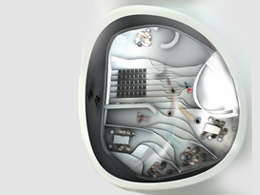STUDENTS PROJECTS
PROJECTS2015

06 July, 2016
Let's meet on the stairs
Our design thesis could be described as an architectural experimentation around the school building.
Students : Papakostas Ioannis, Rontsis Kiriakos
Supervisor: Vergopoulos Stavros
Aristotle University of Thessaloniki
Presentation date : February 2015
Our design thesis could be described as an architectural experimentation around the school building. By conducting experiments around magnetic fields and analyzing them we aim to create spatial tools and therefore dynamic systems, which lead us eventually to our final building proposal.
The idea for our thesis entitled ''school as a meeting field'' arose through our questioning around the school building and our need for a more extensive involvement with it. We noticed that school design follows the standards of institutional buildings, ignoring the special characteristics of children. To better understand how children perceive the school space, we visited schools, in town and in village and subjected the children to small tests. Originally we asked them to try and draw their school and their class and then imagine the ideal school for them. From their plans we tried to draw some conclusions. The most important of these was that they chose to design based on the route they take from the entrance of the school till their classroom, while giving emphasis on the stairs and in the hallways. There was also a large difference in the detail given to their classroom in relation to rooms that are not used frequently by them.

Starting from the fact that the child uniquely perceives his / her natural or built surrounding space, we aspire to create a school that may trigger his / her imagination and thoughts creatively. To achieve this, we think the school as a continuous environment in which different regions or situations coexist. These areas will act as poles magnetizing children's interest and motivating them to move there.
As a first step to realize our case, we chose to examine how magnetic fields work, through which we would extract our design principles. Initially we experimented with magnets and burrs. All the experiments are recorded through photos and videos. Besides filings we also used oil and honey in a try to slow down the motion, which helped us to understand the flows and fields being created and led us to the decision experiment with the magnetic fluid named ferrofuid. In neat at first and mixed with paint later.

The next step was to try to exhaust conclusions of the movement of the liquid towards the magnets and the flows and forms created around them. We conduct the experiments with clear purposes every time, we change the parameters in order to match our needs and then we compare the results graphically. At first stage, where we used neat magnetic fluid, the parameters that change are the number and the strength of the magnets. The conclusions drawn from this stage are the intensity of the field generated around the magnets, their maximum and minimum dimensions and the time in which were created. A particularly interesting feature is that the magnets act in pairs when they are close. By recording the same experiments from closer and focusing on the core of the magnetic field we observed that the particles initially are moving towards the core of one of the magnets first, before they move to the field of the other later.



Having acquired all the information we want from the experiments, we try to reproduce the in a digital way this tome in order to find connections with architectural concepts. We define, this way, the spatial tools that will lead us to create the dynamic system. The first connection is dealing with the definition of the routes around which the space will be formed. The magnets attract, gather and direct the particles creating centers and levels. The second connection concerns the spatial qualities encountered through these routes. In a school there must be sub-regions with different character that will offer a variety of possibilities. This will be accomplished with the production of a deformer, which depending on its properties will determine the amount of the course's deviation. Thus we create open spaces that seek interaction and areas for those who want introversion and isolation.


The next step was to create the dynamic system. We set as our goal to eliminate strong limits between the school and the public space around it. This desire connection determined the initial position of the moving particles during the final system's simulation. The route of the particles as we already mentioned is the one that eventually creates the space. Another new element taking part in our simulation is the educational system with the form of bubbles. Each of these bubbles refers to set of courses that can coexist at the same place as they require the same level of isolation. The final simulation of our system results to be the school building that we propose. In fact, the building consists of three levels. Between these levels the educational spaces are formed. Through these routes and the multiplicity of uses within the same space we try to express the feeling of a school environment that emerged as a product of experimentation procedures.













